Zaatar

We were taking a stroll last summer near Deir El-Kamar, our beautiful hometown in the Shouf mountains. We were at the top of a hill, surrounded by empty fields and we saw an elderly man hunched over bushes carrying huge plastic bags. He turned around to greet us and with a wide grin said ” I am digging up zaatar” (‘am hawwesh zaatar)
That is one of the traditions in Lebanon: digging the wild thyme or zaatar for the family’s consumption throughout the year, or, as this man was doing, for the purpose of packaging it and selling it at the local village markets. Digging up zaatar was the first step. Then the leaves had to be dried, cleaned up and ground to a powder and finally mixed with some salt, sumac and roasted sesame seeds. Zaatar is now ready.
Zaatar is both the name of the wild thyme (Origanum syriacum) that grows all over the mountains and hills of Lebanon and the name of the mix. Its fragrance will be noticeable as you are walking nearby and it is wonderful. Lebanese folks who are experts at using the bounty of nature to its fullest extent use it on a daily basis sprinkled with olive oil on flatbread. The street corner bakeries produces these flatbreads, called man’ooshe, by the thousands every morning. It is also eaten on ka’ak, a type of bread shaped like a small purse, and sold by street vendors.
Now, as a result of intense harvesting by nomadic people, wild zaatar is no longer as widespread as it once was. It is now cultivated in the village of Zawtar in south Lebanon. It can also be cultivated at home from seeds and is a perennial plant.
Thezaatar was always part of our breakfast table, where we wouldmix it with yoghurt cheese or labneh, some olive oil and some pita bread, roll it up and devour in the morning. I loved its pungent, earthy flavor, reminiscent of marjoram and mint.
To say that zaatar is important to the Lebanese is an understatement. Every traditional Lebanese home makes their own zaatar mix. When we would run to the street corner bakery to order our flatbread or man’ooshe for breakfast, my mom and my aunts would adamantly insist on taking our own zaatar to use on the bread. They would not be caught dead eating someone else’s zaatar! Today, I understand why. When zaatar is harvested, the best part is made up of the small leaves, which are ground into a fine powder. The twigs and larger leaves are used commercially ( mixed with bran and citric acid) and therefore not as good.
Zaatar is so important to the Lebanese that a chain of coffee shop aptly called Zaatar w zeit (zeit means oil) opened in Beirut 10 years ago to serve zaatar flatbread 24 hours a day! They are now operating in several countries in the arab world.www.zaatarwzeit.net
The dosage for zaatar is a matter of personal taste. In middle-eastern stores, different types of zaatar mix are sold. Jordanian or Syrian zaatar will not taste the same as Lebanese zaatar, for instance. Some varieties are called green. When you buy it in a bag, it is supposed to be ready. However, it is a good idea to taste a bit first and see if you like it. You may like to add more sesame seeds or more sumac.
INGREDIENTS: This quantity will yield enough zaatar for 2 large flatbreads. It can also last for 2 weeks to be used on yoghurt cheese or on toast. This is the proportion according to Anissa Helou from her book Lebanese Cuisine.
- 2/3 thyme to 1/3 sumac
- 1/4 of the above quantity of thyme and sumac in sesame seeds, toasted or raw
- Salt to taste
METHOD:
If using a zaatar mix:
Use 1/3 cup of zaatar to 1/4 cup extra-virgin olive oil
- Place the zaatar in a shallow bowl.
- Swirl the oil on top mixing the zaatar and oil to the consistency of a wet paste.
If using your own mix:
- Place the thyme, sumac and sesame seeds in a skillet.
- Add some salt, to taste.
- Heat the skillet gently while stirring to mix all the spices.
- Place in a jar, cover and set aside or refrigerate for one year.
- When ready to use, mix a few tablespoons at a time with 1/4 cup olive oil, adding more as needed.
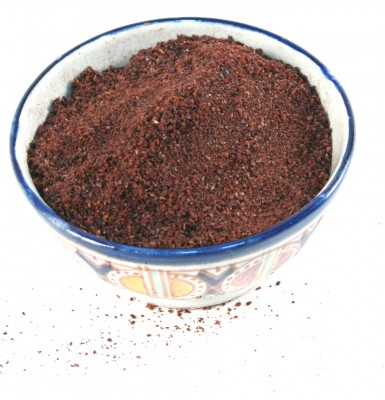
Shown above is sumac, the other spice that is used in the zaatar mix. It taste a bit sour and is often used in Lebanese cooking to replace lemons. It can be found in middle-eastern stores or can be ordered online.
Comments
48 Comments • Comments Feed

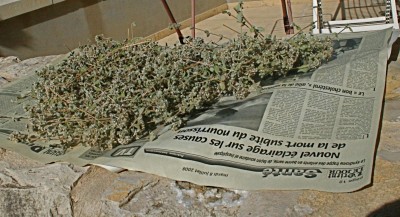
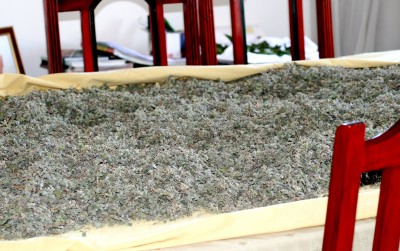
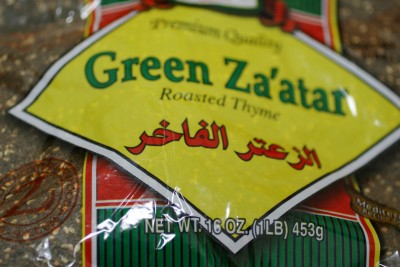
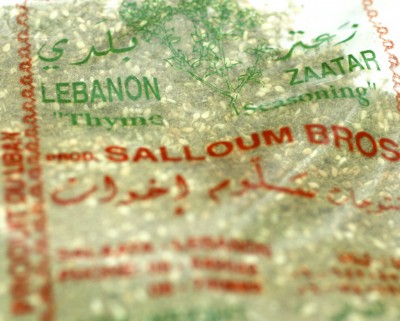
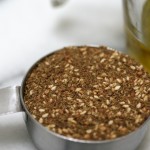
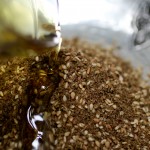
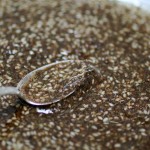
Christie @ Fig&Cherry says:
I love reading your blog for familiar things like Zaatar. I cannot tell you how many people I have had to explain it’s origin and recipe to! Of course my father still eats it everyday with either labneh or shangleesh (spicy cheese, not sure of spelling?). It’s the most aromatic and delicious taste. I hope everyone tries it!
I’ve never tried making it before. Will definitely grow some thyme in my garden next year and give it a go. How do the dried leaves get crushed? In a mortar and pestle?
On October 13, 2009 at 7:37 am
Joumana says:
Christie
Here is the additional info on zaatar: It is called either Origanum syriacum L. or (and) Thymus vulgaris L., is native to the mediterranean. It is a short shrub, with a maximum height of 1 foot. Perennial, can be grown from seed, and planted indoors or outdoors. Grows best in light soils. Does best under partial to full sunlight. It is harvested early in summer and washed in water several times. Left to dry outdoors in the shade for 3 days. Then packaged in bundles and left indoors for 7 to 10 days. The bundles need to be completely dry. The plants are beaten with a stick in order to detach the leaves from the stems. Then it is sifted first in a wide sieve, to remove the stalks from the leaves, then in a fine sieve which separates it into 2 types: Larger leaves and small twigs remain in the sieve (and are used for commercial production) and smaller leaves that fall through the sieve. These are then ground into a coarse powder for zaatar mix or finely ground for cooking. If you are grounding them at home, then I would try to do it with a food processor or a coffee grinder. ( info is from Lebanon’s slow food foundation)
On October 13, 2009 at 8:28 am
Christie @ Fig&Cherry says:
Thank you so much! I’ve bookmarked this page 🙂
On October 14, 2009 at 4:43 am
Jodi Hughes says:
I just tried Zaatar on man ooshe bread for the first time today. I absolutely LOVE it!
I am living and teaching in Al Ain, United Arab Emirates, and I am going to run to the grocery and get it.
Thanks for the information………….Jodi
On November 9, 2009 at 3:55 am
Viviane says:
You are from Deir El Kamar? That is sooo cool, my mom is from a neighboring little town called Kfar Katra. We used to go there a lot after the war to visit my uncle and his family who lived there. I cannot believe it has been so long! My mom and dad used to dig up thyme and mom still makes Zaatar. Honestly it is a totally different taste when it is homemade. I even noticed the difference in basil when I dried a little from a plant we grew at home. The smell is stronger for the homemade ones.
On November 12, 2009 at 2:33 pm
Joumana says:
Hi Viviane,
I recognize the name of Kfar Katra. I will admit that when I am in Deir el-Kamar, I stay put. I agree with you that homemade zaatar is so much better that I refuse to eat the commercial kind. I could live on bread, zaatar and olives.
On November 12, 2009 at 2:43 pm
tobias cooks! says:
this i can do myself with what I find here in Greece. Thanks for the info, sounds like an interesting combination of tastes.
On November 20, 2009 at 2:59 pm
Afaf says:
hi,
i’m from jordan and we add ground hard chick peas and ground roasted wheat to the Zataar mixture , and my mom rubs the thyme with just a little of olive oil .I can eat manaeesh all day 🙂
On July 2, 2010 at 7:21 pm
Yasmine says:
I brought some zaatar and sumac my grandmother had made back from Lebanon and couldn’t get the mix right. Thanks so much for this post!
On August 23, 2010 at 10:58 pm
kouky says:
merci Joumana pour ce billet , car j’étais à la recherche du dosage des différents éléments du zaatar, après avoir eu du sumac en cadeau de mon amie Kaouther .
je vais pouvoir me régaler, habituellement j’ utilise uniquement un mélange de zaatar et le sésame dans la labneh.
En te lisant, j’adore sentir l’odeur de la montagne , du pain chaud et de l’huile d’olive!! bises!
On October 7, 2010 at 5:14 am
Rania says:
Hi Dear,
your site is lovely,I love zaatar so much,and at this time of the year we use it sooo much because we are fasting,so we don’t eat chicken or meat. I wonder if you have any zaatar muffin recipe. I have 2 girls and they not good eaters, I need to make new things for them. by the way I live in Kuwait but I am Lebanese 🙂
On March 3, 2011 at 6:25 am
Joumana says:
Rania
I have a recipe for zaatar scones
https://www.tasteofbeirut.com/2010/11/zaatar-scones-with-labneh/
On March 3, 2011 at 9:11 am
natalia says:
super
On March 17, 2011 at 5:27 pm
Chocolatesa says:
Thank you for the info! This is interesting to read 🙂 I’ll have to buy some to try this!
On April 20, 2011 at 10:24 am
Tulay Azize Tuncay says:
Here in southeastern Turkey we eat zataar for breakfast but also drink zataar tea all year round.
Pack only the dried green leaves in a small tea strainer and pour boiling water over them into a tea glass. I like to drink it straight, but most people put 2 fingers of zataar to 3 fingers boiling water in their glass.
It’s excellent for settling the stomach, too.
On September 10, 2011 at 5:52 am
Joumana says:
@Tulay: Thanks for the tip!
On September 10, 2011 at 7:57 am
Yasmin says:
I have just got the taste of zatar. It’s yummy. Can I sprinkle zatar on top of bread with margarine or butter and eat as a sandwich.
On April 19, 2012 at 4:12 pm
Yasmin says:
Can zatar be used as a spread and just eaten with bread. Or should it be always baked.
On April 19, 2012 at 4:14 pm
Joumana says:
@Yasmin: DEfinitely, this is how people eat it and also mixed in with labneh and olive oil of course; it is a treat to have it baked in a man’ooshe (flatbread), the disadvantage is that if it is baked in a regular oven (as opposed to a saj) it loses its nutritional benefits from the heat (this is what I learned from Lebanon’s foremost zaatar grower and expert, Abu Kassem)
On April 19, 2012 at 11:26 pm
mohannad says:
Great article!!
Thank You!!
On May 31, 2012 at 2:16 am
Smita says:
Love your blog! I am Indian and vegetarian, but looove lebanese food. Your blog has given me so much eye candy :). The vegetarian recipes are all marked by me to try. A, going to start with the zaatar spice mix.
Thanks again!
On August 30, 2012 at 11:02 pm
Joumana says:
@Smita: My pleasure! Love to discover Indian cuisine (so rich and so varied) as well!
On August 31, 2012 at 1:20 am
Nadie says:
Il y tres longtemps (dans les annees 70s) que j’ai mange un morceau d’une baguette de pain avec zaatar et huile d’olive. C’etait mon ami libanaise qui m’avait fait gouter cela, et j’ai adore. Elle etait emigree du Liban avec sa famille et vivait en Cote D’Ivoire. Depuis, je cherche a trouver le melange zaatar. J’en ai trouve dans un magazin libanais a Ottawa, mais je n’etait labas que pour quelques jours. Puis-je trouver ce melange par internet? Est-ce que tu connais un magazin qui vent la zaatar libanais?
On December 22, 2012 at 7:32 pm
Joumana says:
@Nadie: Il y a plusieurs companies qui vendent le zaatar en ligne; une s’appelle buylebanese.com ; tu peux aussi cliquer sur Amazon et voir ce qu’ils proposent.
On December 23, 2012 at 1:43 am
Colette says:
Hi, where can I buy (online over the internet) Zaatar from LEBANON. I live in the United States. thank you.
On March 7, 2013 at 12:31 pm
Joumana says:
@Colette: There is a website (I am NOT affiliated with it) called buyLebanese.com and they sell zaatar from Lebanon; also, there is al rifai which has a website in which you may find zaatar; I used them once to ship pistachios to my son.
On March 8, 2013 at 1:49 am
Bashir says:
been looking good recipe for Zaater this the best by far, will give a try this week.
Thanks
On April 29, 2013 at 11:57 am
michael says:
I’m curious about the “set aside or refrigerate for one year” part.
does sitting for a year improve the flavor – or do you mean it’s good for one year?
I ain’t got no time for that! 😉
On December 17, 2013 at 5:14 am
Joumana says:
@Michael: I just mean it is good for at least a year.
On December 17, 2013 at 5:29 am
SONIA PAPADOURI says:
Well!!! I’m half Greek and half Armenian.. I got to know zaatar on a vacation trip to Lebanon…. Later I got a job in Egypt and I find it there too!!! Now I’m back in Cyprus and -THANK GOD- I have friends in Jordan that provide me with this exquisite taste!!! I can’t live without it!!! I spread a thick layer of pure butter on my bread and I just overturn it on the open bowl of zaatar, press it a little and…… Mouthwatering!!!! I’m going to go and have some now actually!!! ha ha ha Thank you for everything Joumana! God bless you!
On April 23, 2014 at 8:37 am
Joumana says:
@Sonia: Thanks for your cheerful message! You made my day 🙂
On April 23, 2014 at 8:49 am
vickah says:
I was just googling an ngredient on my jar of Jordanian zaatar. When I looked up Origanum, oregano came up… NOT thyme. Somehow I found your article… so lovely, an informative memoir. I lived in Beirut in 1975 and remember the delicious sour taste of zaatar, apparently the sumac. This one by Sahadi does not have sumac listed as an ingredient. It doesn’t jump out with flavor like I remember zaatar. Guess I will have to return to Lebanon and find the real stuff! Thanks so much for writing this.
On March 12, 2018 at 5:09 pm
Helen says:
Twenty years ago I bought fresh ZAATTAARR from a spice booth at a fair just north of Santa Fe, NM. I fell in love with it and use it on grilled meats with lemon juice instead of seasoned salt. Recipe on his home-made label gives ingredients as ‘roasted sesame, oregano, theyme, and sumac’. I re-ordered once, but I can no longer get in touch with his Spice Caravan. I finally found your pictured Salloum Bros. Lebanon Zaatar as the closest to his simple recipe, but no oregano in the ingredient list. As is, how much ground oregano should I add to Salloum Bros. to maybe get close to his recipe? If all 4 ingredients are in equal amounts, maybe I should add 1 tablespoon to 4 tablespoons of Salloum? Running low as it is, H
On October 15, 2019 at 2:23 am
Cicerone says:
Hi Joumana,
I never had zaatar and I am going to try it these days. There are Lebanese style, Jordanian style, Jerusalem style, etc. What makes the difference? Which should I try first. Your time and effort to reply will be greatly appreciated. Thank you.
Edmonton, Alberta
On June 15, 2021 at 3:07 am
Joumana Accad says:
@Cicerone Each zaatar has different spices to make-up the mix. It is a matter of tasting different ones and picking your favorite. I personally love the one from Aleppo which has pomegranate in it, and of course the Lebanese one, provided it is made with the best ingredients.
On June 24, 2021 at 6:25 pm